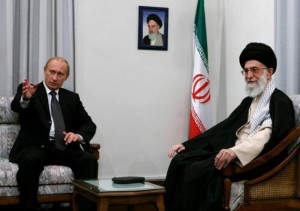 Expectations that Iran would move closer to the US after the nuclear deal have to be put aside, at least for the foreseeable future. Supreme Leader Khameini has closed off further dialog with Washington, synchronized the media with the mullahs and generals, tested the limits of the nuclear deal, and aligned his country’s foreign policy with Russia’s.
Expectations that Iran would move closer to the US after the nuclear deal have to be put aside, at least for the foreseeable future. Supreme Leader Khameini has closed off further dialog with Washington, synchronized the media with the mullahs and generals, tested the limits of the nuclear deal, and aligned his country’s foreign policy with Russia’s.
Iranian troops serve on the ground in Syria with Russian air cover. More recently, Iran and Russia have engaged in high-level meetings and in the last few weeks, begun an effort to weaken the US position in Iraq, if not end it altogether. The move is short-sighted.
Dilemma for Iraq
Russia has offered to expand its air campaign in support of Syrian forces into supporting those of Iraq, which heretofore have relied on US airpower. Nothing has yet come of Russia’s offer, though.
More recently, Shia militias backed by Iran have warned that if US ground troops were reintroduced into Iraq, the Shia fighters would battle them. Shia politicians, many of them from movements aligned with Iran since the Iran-Iraq War of the eighties, have also voiced fierce opposition to a greater US presence.
Despite continued common danger from ISIL, Shia militias have skirmished with Kurdish peshmerga, who have driven ISIL from their lands – with US help. Iranian special forces have played a part as well, though not as substantial a part as Tehran wishes. Shia militias have brought Shia Kurds into their ranks to fight their kin.
The Baghdad government of PM Abadi, himself a Shia, has thus far refused to heed the anti-US counsel from Tehran, Moscow, and his fellow politicians.
The US has countered by offering Abadi US helicopter gunship support and tactical military advisers for the ongoing battle to expel ISIL from Ramadi. This affords Abadi the opportunity to draw from American, Iranian, and perhaps Russian resources, without becoming overly dependent on either side – a judicious move, but one that Tehran and Moscow will not like.
Risk for Iran
Attempting to expel the US holds little risk for Russia but a considerable amount for Iran. Iran’s antipathy toward the US risks alienating Kurdistan which has benefited from American support against Saddam and ISIL. Kurdistan will be loth to see the US pushed out. It wants US support in selling crude in the West and ultimately in gaining fuller autonomy and one day, independence.
The US has recently signaled that Kurdistan figures in its plans for a network of bases to counter Islamist militancy from West Africa to Central Asia. That will entail aid, arms, and diplomatic support.
Increased tension between Kurdistan and Iran will lead to greater unrest in the Kurdish region of northwestern Iran. It could preclude a potential export route for Kurdish oil through Iran’s pipeline system.
The Iranian-Russian pressure could also lead to the further disintegration of Iraq. Kurdistan is already well out the gate and the Sunni west is now more part of Isil-stan than Iraq. If Baghdad moves closer to Iran, Sunni hostility will grow immensely, both in Iraq and the region, and determination to fight the “Persians” will find generous regional support.
There is potential for Kurdistan and Sunni-stan not only to distance themselves from Iraq and Iran, but also to rely far more on the US and the Sunni monarchies – a calamity for Iran. Tehran’s anti-US policy reflects theocratic and military certainty more than it does the pragmatism that has been in evidence over the last quarter century. The policy also reflects a trust in Russia that is unwarranted and dismissive of centuries of hostility between the two countries.
©2015 Brian M Downing